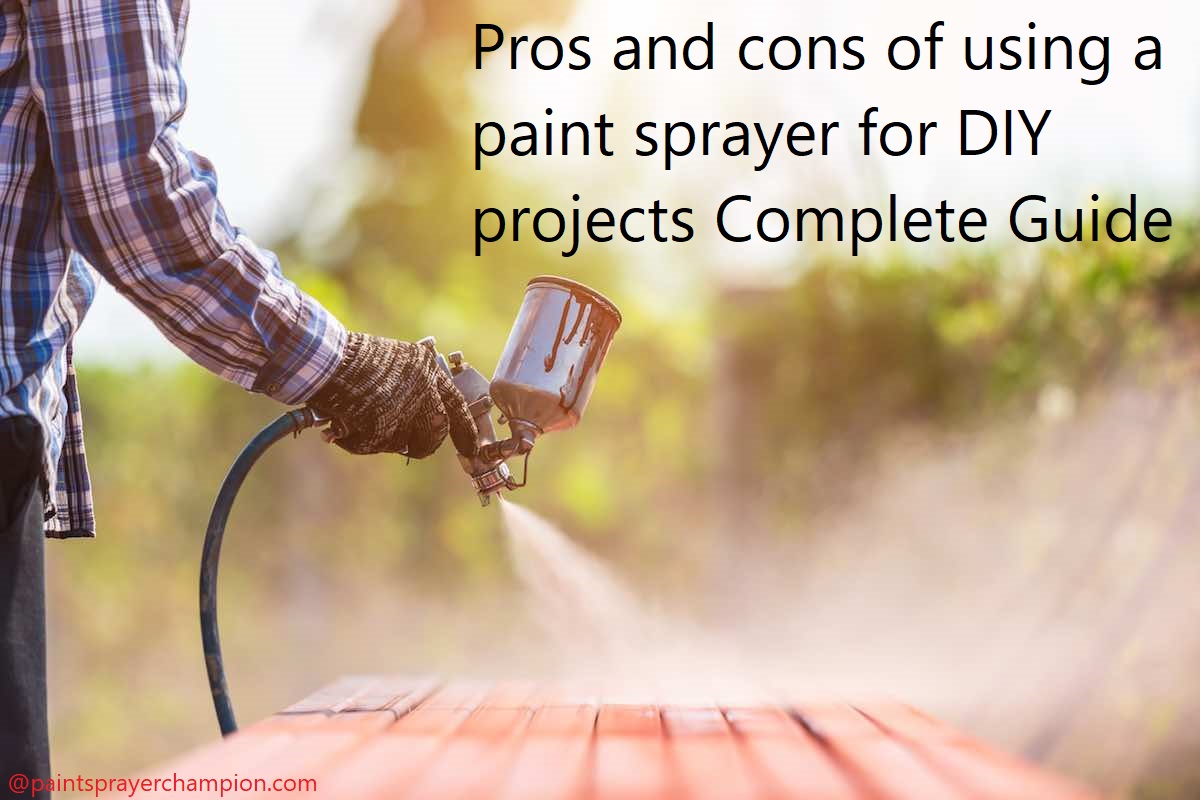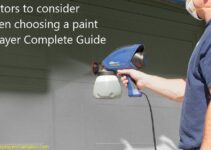Have you ever considered simplifying your DIY projects with a paint sprayer? If so, you’re in the right place!
This guide outlines the advantages and disadvantages of using a paint sprayer, so you can make an informed decision on the best tool for your needs. Make sure to read on to find out how you can get the perfect finish with your next painting project.
Paint sprayers are an important tool for a variety of DIY projects. They make painting easier, faster, and more consistent than traditional brushes and rollers, and can eliminate dripping and splattering for a smoother finish. In addition to saving time, paint sprayers can also save money. However, there are some drawbacks to their use that must be considered. This guide will explain the advantages and disadvantages of paint sprayers so you can decide if they’re right for your next project.
Starting with the positives, paint sprayers can help you achieve professional-looking results in much less time than traditional methods. For example, painting a door with a roller or brush can take hours; however, it could be done much more quickly with a paint sprayer. It also provides superior coverage since the material is evenly spread through the air by a powerful turbine or piston engine. Furthermore, it reduces drips and runs on both vertical and horizontal surfaces- if used correctly – creating minimal messes.
As far as negatives go, paint sprayers require special skill level to use them effectively without wasting material or making huge messes in your home or workspace. Not all materials can be sprayed by these devices: some items such as furniture cannot be successfully sprayed with this device due to size constraints; heavier surface coatings may not provide satisfactory results as well; solvent-based coatings require additional precautions due to their hazardous nature; if not used properly they create a great deal of overspray which needs special treatments for disposal. Additionally users should take precautions when using the device due to noises coming out from them during operation – ear protection should always be worn while operating them. Finally, they require regular cleaning and maintenance after every job which adds an extra layer of work on top of painting tasks.
Explanation of paint sprayers
Paint sprayers are ideal tools for achieving a professional-looking finish quickly and easily. A modern paint sprayer comprises of three main components: a compressor, a spray gun and a hopper that carries the paint. Through these components, compressed air is pushed through the hopper containing the paint, creating an aerosol mist which is then sprayed onto surfaces. Paint sprayers allow users to cover large areas with paint quickly and easily, making them useful for larger projects such as outdoor furniture or pathways. Furthermore, they provide superior coverage over traditional painting tools such as rollers and brushes; plus, because paint is atomized into small particles upon being sprayed from the gun, there is little to no risk of errors in application such as spattering or streaking.
Paint sprayers are particularly popular in DIY projects because of their affordability; however it should be noted that although they can save time by allowing larger areas to be covered in one go compared to traditional painting tools there will still be some preparation work required before using one. Plus, due to their high-pressure systems regular maintenance will also be needed in order to ensure the longevity of the tool itself and also keep its performance level at its optimum state. In terms of cost savings depending on what type of project you’re undertaking there may not necessarily be much benefit over manual methods; particularly if it’s just a simple interior project such as walls or furniture where equipment such as masks would need to be purchased and additional precautions taken due to the number of hazardous fumes created during use. Nonetheless since maintenance costs are quite minimal with this type of tool combined with its ease-of-use depending on your needs it may still prove beneficial in some cases.

Importance of paint sprayers in DIY projects
Paint sprayers are one of the most important tools for DIY projects, as they make the job much easier and faster. Paint sprayers are a great tool to use when you need to cover a large surface area quickly and uniformly. A standard paint brush may take several hours to complete a project that could be covered in minutes with a paint sprayer. Moreover, using a paint sprayer gives consistent results every time, which is difficult to achieve with other painting methods.
Another benefit of using a paint sprayer is that it can help you save money by being able to purchase larger quantities of paint at once and then simply store it for future use. When compared to brushes, rollers or traditional painting methods, painters who use a good quality paint sprayer may require fewer coats of paints and take less time to finish their projects. This means that you are able to save money on both labor and materials as well as reduce the amount of time it takes you to complete your project.
Paint sprayers also provide more precise and even coverage than other methods, making them especially useful for outdoor surfaces such as decks or fences that have areas where it can be harder to reach with either brushes or rollers. Since these types of projects tend to involve large surfaces, there is no better way than using a paint sprayer for staining these items without creating unwanted runs or drips along the surface. In addition, some types of specialty paints such as elastomeric coatings are nearly impossible to apply effectively without using an airless painter or airassisted airless system – both common types of industrial strength paint spraying systems used in home improvement projects when required.
Purpose of the guide
This guide is intended to provide an overview of the pros and cons of using a paint sprayer for DIY projects. Paint sprayers are an increasingly popular option for completing projects quickly and with minimal effort. In this guide, readers will learn about the different types of paint sprayers available on the market, as well as tips and tricks to ensure successful completion of their DIY project when using one.
Additionally, readers will receive insight into the potential drawbacks associated with using a paint sprayer, and how best to overcome them. Finally, readers can learn more about understanding safety procedures when working with a paint sprayer and its components.
With this comprehensive guide in hand, users can make informed decisions when choosing to use a paint sprayer for their next DIY project!
Pros of using a paint sprayer for DIY projects
The primary advantage of using a paint sprayer for DIY projects is the speed and efficiency it can provide. This type of sprayer can apply a uniform coat of paint quickly and evenly, saving DIYers time and effort when completing a project. Paint sprayers can also help minimize the amount of clean up necessary for projects since most leave very little overspray, reducing the need for sanding or reworking areas where there was too much or too little coverage.
In addition to its fast application, using a paint sprayer allows you to achieve finer results than brushing or rolling alone. Since paint is applied in much smaller droplets than when brushed or rolled on, your coat will be more even and even lines will be easier to achieve with a professional finish at the end. Because it uses much less product than traditional methods, it can also save you money in the long run by requiring fewer coats of paint and less material overall.
Time-saving
One of the main advantages of using a paint sprayer for DIY projects is that it can be a time-saver. When painting by brush and roller, you have to wait for each coat to dry before applying another. With paint sprayers, you can quickly cover large surfaces with just one coat. This allows you to move quickly from one area of the project to the next without waiting for long periods between each step in the process.
Additionally, because most consumer-grade paint sprayers will work with thicker paints, there is no need to thin your paints for use in a sprayer. This means less preparation time before you can begin spraying.
Uniform coverage
One of the main advantages of using a paint sprayer is the uniform coverage it provides. If you want to give your walls or furniture a professional look and feel, then a paint sprayer can be very useful in achieving this goal.
The spray produced by the machine will give an even finish, eliminating streaks or uneven patches that may be caused by painting with a brush or roller. Paint spraying machines offer an easier and more economical alternative to traditional painting methods.
Reduced paint wastage
The use of a paint sprayer can reduce the amount of paint used significantly when compared to traditional painting methods. This is due to the even and efficient coverage of paint provided by a paint sprayer, which eliminates wastage by providing even amounts of coverage over all surfaces without retaining any extra paint. As such, it is an effective tool for avoiding unnecessary waste in DIY projects.
Additionally, since most paint sprayers come with adjustable settings, users are able to adjust how much pressure they need and how far their paints should shoot out -this allows them to exactly optimize their usage according to the particular requirements of a project. As such, it is an environmentally friendly decision that small businesses may want to take into consideration when pursuing any sort-of DIY painting project.

Enhanced finish
Spray painting is a great way to give your DIY project an enhanced finish. Application using a paint sprayer allows you to achieve a professional quality finish with just minimal effort. The process of spraying reduces the brush and roller marks which create an even and attractive surface. Since the paint is being dispersed thinly and uniformly across the surface, multiple coats are unnecessary. This both saves time and helps conserve paint.
Along with this, you can use a wide variety of different paints such as lacquers, varnishes, stains, oil based paints and water based paints which are all applicable when using a spray gun or airless sprayer for your DIY projects. Over-spray does not need to be a concern either when applying with proper equipment; making the entire process much less messy than traditional painting methods used for these same projects.
Cons of using a paint sprayer for DIY projects
As with any tool, paint sprayers do have their drawbacks. While they provide greater efficiency at a lower cost, there are definite disadvantages to be aware of before investing in a paint sprayer for DIY projects. Below we’ve outlined the most common cons to consider:
- Time-Consuming Setup and Cleanup: Paint sprayers require more time for setup and cleanup than traditional painting with a brush and roller. This involves preparing the area to be painted, setting up the clothing and masks, prepping the machinery, cleaning the air hoses, etc., which can be quite tedious and take up an entire day of your weekend if you’re not well-prepared.
- More Expensive Upfront Cost: Paint sprayers are more expensive than traditional paint tools like brushes and rollers due to their higher quality material construction and ability to offer greater efficiency. Typically they range in price from $50 – $400 depending on model type and size. If you’re looking to save money in the long run through improved efficiency, though, these initial costs can pay off over time by reducing labor fees or simply getting the job done faster.
- Overusage: Unless you’re a seasoned pro – it can be very hard for a beginner DIY-er to control how much paint is sprayed on each project when using a paint sprayer for DIY projects—which can lead to overusage of your materials or wasteful overspray that doesn’t result in coverage on woodwork or walls properly requiring additional coats which of course wastes time and money as well!
Cost
The cost of using a paint sprayer is often one of the primary concerns when tackling DIY projects. Many people may initially assume that the cost of buying and operating one of these machines is beyond their budget, but on the contrary, there are now quite a few affordable options available.
Paint sprayers are more cost-effective than purchasing gallons of paint and require less labor (you only need to use 1/3 as much material when compared to painting with a brush). The money saved on materials can then be invested in other essential aspects of your project, such as quality brushes and masks if they are needed.
Over-spray
When using a paint sprayer, it is important to consider the amount of over-spray that will be created in the painting area. Over-spray refers to the excess paint particles that are dispensed out of the nozzle of the paint sprayer and land on objects outside of the intended project area. Over-spray can cause unintended splatters and messes as well as create a less controlled result with an uneven layer.
To minimize over-spray, use shields or breathable plastic sheets to contain any particles and ensure that your finished project looks clean and neat. Additionally, making sure you are using the correct nozzle for your project can also help reduce over-spray.
Difficult to use
Using a paint sprayer can be difficult since the results depend on how well the user follows the instructions. The user must have some experience with using a paint sprayer, as well as good coordination and hand-eye coordination. Improper spraying technique can lead to an uneven coat or drips and runs.
Additionally, it can be difficult to reach areas that are far away from the spray gun, such as corners and other tight areas. Also, strong air currents can cause overspray and make it hard for the user to keep a consistent coating thickness. The user must additionally make adjustments for different painting conditions, such as humidity and temperature levels, in order to get good results from their paint sprayer.

Conclusion
In conclusion, deciding whether to use a paint sprayer for your next DIY painting project is mostly a matter of weighing the pros and cons. Paint sprayers can provide you with fast, even coverage and can save you time and effort by quickly covering large surfaces. However, before investing in a paint sprayer, it’s important to consider any special preparations or extra steps that may be needed for your project. You should also make sure to properly clean and store the sprayer!
Ultimately, if you’re willing to take the time to do research on the best techniques for using a paint sprayer, you’ll likely find that this tool can make your next DIY endeavor much less painful.
FAQ’S
What are the disadvantages of using a paint sprayer?
Some disadvantages of using a paint sprayer include the risk of overspray, the need for proper ventilation, the need to thin some types of paint, and the cost of equipment.
What are the advantages of a paint sprayer?
Some advantages of using a paint sprayer include the ability to cover large areas quickly, achieving a smooth finish, and allowing for precise control over paint application.
Is it worth it to get a paint sprayer?
It depends on the individual’s needs and preferences. A paint sprayer can be a good investment for those who need to cover large areas quickly and achieve a smooth finish.
Are paint sprayers good for beginners?
While paint sprayers can be challenging to use for beginners, they can be a good tool to learn with, especially with practice and proper technique.
What are the problems with paint spraying?
Some problems with paint spraying include overspray, clogging, and the need for proper ventilation.
Is it better to paint by hand or sprayer?
It depends on the project and personal preferences. Painting by hand may be more suitable for smaller projects, while a sprayer may be better for larger surfaces.
Is paint sprayer better than brush?
A paint sprayer can be better than a brush for some projects, especially for covering large areas quickly and achieving a smooth finish.
Do paint sprayers work better?
A paint sprayer can work better than other methods for some projects, such as covering large areas quickly and achieving a smooth finish.
Is it better to paint with a brush or sprayer?
It depends on the project and personal preferences. Painting with a brush may be more suitable for smaller projects, while a sprayer may be better for larger surfaces.
Is spraying cheaper than painting?
It depends on the project and the cost of equipment. While a sprayer can cover large areas quickly, the initial cost of equipment can be more expensive than using traditional painting methods.
See Also:
- Best indoor paint sprayer
- Best sprayer for latex paint
- Best professional paint sprayer
- Best paint sprayer
- Best paint sprayer under $100


